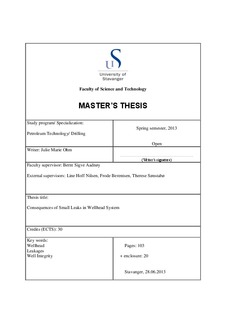| dc.contributor.author | Ohm, Julie Marie | |
| dc.date.accessioned | 2013-11-12T14:53:13Z | |
| dc.date.available | 2013-11-12T14:53:13Z | |
| dc.date.issued | 2013 | |
| dc.identifier.uri | http://hdl.handle.net/11250/183577 | |
| dc.description | Master's thesis in Petroleum engineering | no_NO |
| dc.description.abstract | An increased frequency of minor gas leakages from seals in the wellhead (WH) area have been detected and recently given an increased focus among companies on the Norwegian continental shelf. Among others have Statoil and Shell reported concerns regarding this problem and are working simultaneously to identify and solve the problem.
There is however uncertainties in the industry related to how the problem regarding leakages in the WH can be solved, how critical the leakages actually are, the extend of the problem, and whether test of the seals actually can trigger a leakage itself or not. Questions regarding whether the seals should be tested on a general basis and regarding specific maintenance plans for the seals have been raised.
It has not been a common practice over the last years to test the seals in the WH after installation. It is therefore difficult to evaluate the extent of this problem as very limited test data exist. In addition, integrity issues in connection to the small cavities in the WH do often show unambiguous test results.
Three case studies of three wells at the Oseberg East installation (Statoil) will be presented in this thesis. The case studies have been carried out with the use of the exclusion methods, analysis of pressure and trends, tests results, and simulations of hypothetic scenarios. The main discoveries follow below:
It is indicated that the leakages in the seal assemblies in the WH are caused by:
• Design capabilities exceeded in operation
• Unsuccessful conversion of producers with an inactive A-annulus to producers with gas lift.
• Dirt and residual hydraulic oil from installation.
• Problems related to vibration
• Pressure tests of the DHSV
• Faulty design of WH
A review of the barriers on the wells concludes that the wells have in the first place two independent barriers that are possible to test. An additional third barrier gives increased safety against leakages to the atmosphere if seals fail. It is not possible to test the seal in the third barrier without introducing a risk to damage a unidirectional seal in the secondary barrier.
It is considered that the frequency of the leakages to the atmosphere is expected to increase with time. It is in particular expected that the total number of leakages will increase through the test ports.
The consequences of these leakage rates are considered to be negligible compared with the rates of leakages that are considered to give high risk of explosion and/or fire.
The leakages might however be of significant enough size to be detected by the gas-detector and thereby cause the production at the installation to be shut down.
The test ports should be monitored and an increased focus on maintenance should be initiated. With these initiatives, leaks to the environment are considered to represent a negligible risk.
It is a severe escalation of the leakage to cavities in the wellhead, if the consequence is that the unidirectional seal in the secondary barrier becomes weakened. This danger is reduced by being able to monitor the pressure between the elastomer seal and the unidirectional seal.
Examples of recommended compensating measures that will be discussed are:
• Pressure monitoring
• Use of foam around test plugs
• Use of chemical sealant
• Evaluate injection of nitrogen to cavities
It is recommended to bleed of pressure in the WH cavities before performing test on DHSV or commencement of other well activities.
New recommended accept criteria’s in the WH follows:
• Operate the well with a 35 bar limit in the cavities
• AC. for leakages :
o 35 bar/24hr for internal leakages
o 0,1 kg/s for leakages to the atmosphere
The case studies that have been carried out are related to gas lift wells. There is however indication that minor gas leakages in the WH might exist on other types of wells as well. | no_NO |
| dc.language.iso | eng | no_NO |
| dc.publisher | University of Stavanger, Norway | no_NO |
| dc.relation.ispartofseries | Masteroppgave/UIS-TN-IPT/2013; | |
| dc.subject | petroleumsteknologi | no_NO |
| dc.subject | boreteknologi | no_NO |
| dc.subject | wellhead | no_NO |
| dc.subject | leaks | no_NO |
| dc.subject | lekkasjer | no_NO |
| dc.subject | well integrity | no_NO |
| dc.title | Consequences of small leaks in wellhead system | no_NO |
| dc.type | Master thesis | no_NO |
| dc.subject.nsi | VDP::Technology: 500::Rock and petroleum disciplines: 510::Petroleum engineering: 512 | no_NO |
